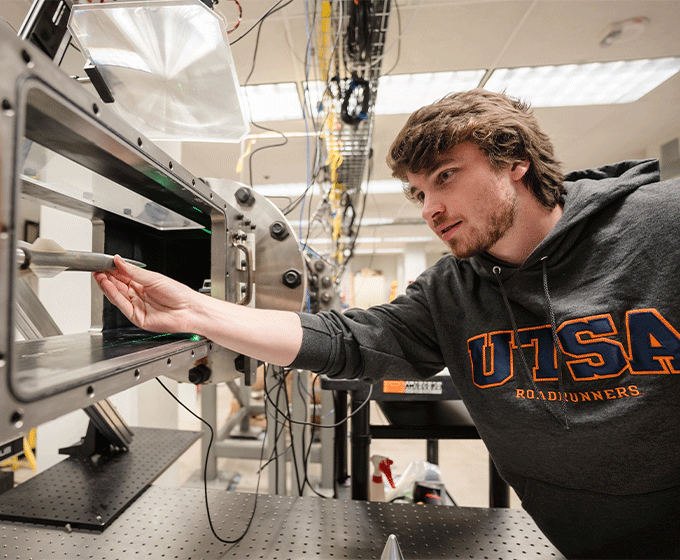
MAY 3, 2024 — UTSA recently broadened the sphere of collaborators in its space research enterprise by joining the Universities Space Research Association (USRA). The association facilitates cooperation between federal government, foreign governments, higher-education institutions and other organizations in the development and application of space-related science, technology and engineering programs. A supermajority of USRA’s Council of Institutions approved UTSA’s admission.
“Our admission to the Universities Space Research Association affirms our position as a prominent leader in space technology and exploration for the State of Texas as we continue to grow our academic programs and expand our strategic partnerships with key industry leaders like the Southwest Research Institute (SwRI),” said UTSA President Taylor Eighmy. “As we work toward becoming a great public research university, our affiliation and collaboration with USRA will significantly advance our impact as both a knowledge enterprise and economic driver for the region and nation.”
USRA is a nonprofit organization chartered to advance space-related science, technology and engineering. USRA operates scientific institutes and facilities and conducts other major research and educational programs. An association of 120 university members, it engages the broader university community, including faculty, students, post-doctorate students, adjunct faculty members and other research organizations affiliated with universities. USRA employs in-house scientists and engineers, who work for USRA directly and are assigned to projects for NASA or other institutions. USRA also offers innovative research, development and project management expertise.
The association works closely with the university space research community, collaborating with 234 universities on research projects in the last year alone. In addition to UTSA, USRA recently welcomed the University of Notre Dame and the University of Padua.
David Silva, UTSA Distinguished Professor of Physics and Astronomy, commented on the benefits of USRA membership.
“Joining USRA opens new and exciting research and education opportunities for students and faculty alike,” he said. “UTSA is deeply engaged with the U.S. space science and technology ecosystem through our investments in aerospace, artificial intelligence, cybersecurity, data science, planetary science and space physics.”
Silva, an astrophysicist, is currently investigating how galaxies including our own Milky Way form and evolve using machine learning and other modern data science approaches to analyze large public datasets that contain information on billions of stars and galaxies. Prior to joining UTSA, Silva served as Director of the National Science Foundation's National Optical Astronomy Observatory (NOAO), the U.S. national observatory for night-time optical-infrared astronomy for 10 years.
 Christopher Combs
Christopher CombsChristopher Combs, an associate professor of mechanical engineering who heads up the UTSA Hypersonics Lab in the Margie and Bill Klesse College of Engineering and Integrated Design (Klesse College), described the membership as “an excellent opportunity for UTSA to engage with technical experts both at USRA and other affiliated research institutions.”
Combs’ research background is in high-speed aerodynamics and its applications for space access, defense and commercial aviation. His research team has done work for organizations such as NASA, the Air Force, the Navy, the National Science Foundation and the U.S. Under Secretary of Defense.
Combs added, “USRA has strong connections with NASA in particular, and we look forward to partnering on future research efforts.”
Combs noted that he expects UTSA to make significant contributions to the USRA in several areas, including hypersonics.
“A key area of expertise for USRA is in aeronautics research, which is also a strength at UTSA,” he said. “I see much potential for collaboration here on a variety of projects related to aerodynamics, high-speed flight and space access, given the research activities of current UTSA faculty.”
Research in these areas is made possible by UTSA’s research centers and facilities that support novel, interdisciplinary space-related research. These include the Center for Advanced Measurements in Extreme Environments, the Kleberg Advanced Microscopy Center, the Wireless Next Generation Systems Laboratory, the Heat and Mass Transfer Experimental Rheology Lab, the Extreme Environments Materials Laboratory, the Laboratory of Turbulence, Sensing, & Intelligence Systems, and the Klesse College’s Unmanned Systems Lab. In addition to these laboratories, UTSA owns multiple research assets, including a Mach 7 Ludwieg tube wind tunnel, a high enthalpy shock tube, and several research-grade telescopes in the Curtis Vaughan Jr. Observatory on the Main Campus.
 JoAnn Browning
JoAnn BrowningJoAnn Browning, UTSA interim vice president for research, added that the USRA membership comes at an important time in the university’s growth as a preeminent research university and the growth of the Texas economy.
“The Texas Space Commission has recognized the need to accelerate research and development in space science and allocated $150 million to the Space Exploration and Aeronautics Research Fund,” she said. “UTSA is responding to this need as we support our growing research thrust in space science and technology. These developments, coinciding with this new membership, make UTSA a premier institution to conduct space research.”
Silva also commented on the fortuitous timing of the membership.
“A new space race is underway, and Texas is one of the leaders,” he said. “Now is an excellent moment to deepen the engagement of our students and faculty in the local, state and national space science and technology ecosystem through USRA membership.”
UTSA faculty have made significant contributions to space sciences research in recent years. For example, leading up to the total solar eclipse last month, Angela Speck, professor and chair of the UTSA Department of Physics and Astronomy, was a leading expert in providing insight into the event.
 Xinting Yu
Xinting YuIn 2023, UTSA astrophysicists partnered with the Subaru Telescope and the European Space Agency to capture one of the first-ever images of an exoplanet seen by the James Webb Science Telescope (JWST). That same year, NASA recognized UTSA faculty Xinting Yu with a Planetary Science Early Career Award, aimed at establishing a Planetary Material Characterization Facility. In 2022, UTSA astronomers played a pivotal role in the Event Horizon Telescope project, contributing to the first-ever image of black hole Sagittarius A*. UTSA faculty have also partnered on several NASA-funded small business innovation and technology transfer projects.
“UTSA’s academic programs, research and development in space science continue to evolve by leaps and bounds, and our strategic partnerships across sectors and industries have been key to this momentum,” Browning said. “Our collaborations with Subaru and NASA are evidence of what can be accomplished through partnerships. We are excited that our institution has joined this important association and confident that the ensuing collaborations will lead to further groundbreaking advancements that enrich our students’ and researchers’ experience at UTSA, as well as our understanding of space.”
 Saugata Datta
Saugata DattaSaugata Datta, professor and chair for the UTSA Department of Earth and Planetary Sciences, also believes the membership will serve as a catalyst for both new and existing partnerships.
“We’re joining a consortium that will expand the opportunities for students and faculty to conduct research in space science and planetary science in conjunction with other institutions and industry partners, alongside Southwest Research Institute (SwRI),” he said.
Faculty from UTSA colleges can also collaborate with researchers from multiple groups at SwRI through UTSA’s Space Travel, Exploration and Planetary Science (STEPS) Research Interest Group (RIG).
Datta researches and lectures on terrestrial analogs, environments on Earth that mirror extraterrestrial environments. Researchers study these environments to extrapolate how they may function on other planets.
Students and faculty in the UTSA Department of Earth and Planetary Studies also research astrobiology, planetary surface processes, planetary atmospheres and lunar and planetary science, one of USRA’s focus areas. Students also learn about how the Earth and other planets formed and continue to evolve.
Meanwhile, the UTSA Department of Physics and Astronomy also offers opportunities to study and research space science. It offers bachelor’s, master’s and doctoral programs in physics and manages the Space Physics Graduate Program in collaboration with SwRI. Faculty members are actively engaged in research in several areas including astrophysics and cosmology, biophysics, computational physics, experimental and theoretical condensed matter physics, materials science and nanotechnology and ultramicroscopy. In addition to its range of physics courses, the department also offers courses in astrophysics, cosmology and relativity.
UTSA Today is produced by University Communications and Marketing, the official news source of The University of Texas at San Antonio. Send your feedback to news@utsa.edu. Keep up-to-date on UTSA news by visiting UTSA Today. Connect with UTSA online at Facebook, Twitter, Youtube and Instagram.
Huddle Against Hunger is a fundraising competition with Texas State that benefits our Roadrunner Pantry. Donations this week will help UTSA earn additional prize monies provided by RBFCU.
In-Person and VirtualJoin UTSA Libraries for an update on federal public access policies and how the library can assist with compliance.
Virtual EventWe invite you to join us for Birds Up! Downtown, an exciting welcome back event designed to connect students with the different departments at the Downtown Campus. Students will have the opportunity to learn about some of the departments on campus, gain access to different resources, and collect some giveaways!
Bill Miller PlazaThere are many citation managers. Which one is right for you? This workshop will explain what a citation manager is and how it can help you organize your citations, insert citations as you write your paper, and generate your bibliography.
Virtual EventPubMed is an essential database for anyone conducting biomedical or health-related research. This workshop will teach attendees how to effectively navigate this free resource and locate peer-reviewed articles using advanced search features, MeSH subject headings, and Boolean operators.
Virtual EventIn this hands-on workshop, participants will learn to setup an EndNote library, save references and PDFs, and automatically create and edit a bibliography. Attendees are encouraged, but not required, to have EndNote already installed on a personal computer.
Virtual EventJoin UTSA Libraries and Museums to learn more about the publishing discounts available for UTSA researchers. Current agreements include Elsevier, Cambridge University Press, Wiley, and more. Bring your questions and feedback for the library as we continue to pursue partnerships with publishers to reduce costs for our researchers.
Virtual EventThe University of Texas at San Antonio is dedicated to the advancement of knowledge through research and discovery, teaching and learning, community engagement and public service. As an institution of access and excellence, UTSA embraces multicultural traditions and serves as a center for intellectual and creative resources as well as a catalyst for socioeconomic development and the commercialization of intellectual property - for Texas, the nation and the world.
To be a premier public research university, providing access to educational excellence and preparing citizen leaders for the global environment.
We encourage an environment of dialogue and discovery, where integrity, excellence, respect, collaboration and innovation are fostered.